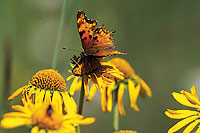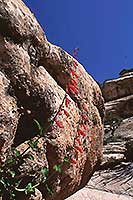 Spring represents an anticipation of warm days, clear nights, rising river levels, dry trails, and a profusion of wildflowers that herald the season. Depending upon interest, whether it’s camping in Arches National Park beneath a star-studded sky, riding the White Rim Trail through the geologic history of Canyonlands National Park, rafting the Colorado River, or hiking across slickrock to a spectacular overlook, the desert just seems more inviting when the wildflowers bloom.
Spring represents an anticipation of warm days, clear nights, rising river levels, dry trails, and a profusion of wildflowers that herald the season. Depending upon interest, whether it’s camping in Arches National Park beneath a star-studded sky, riding the White Rim Trail through the geologic history of Canyonlands National Park, rafting the Colorado River, or hiking across slickrock to a spectacular overlook, the desert just seems more inviting when the wildflowers bloom.
Showy candelabras of narrow-leaf yucca flowers emerge from a protective envelope of spine-tipped leaves. The fairly large, cream to white-colored bell-shaped flowers hang downwards with the oldest flowers at the bottom. During the day, the glossy petals draw closer, but at night the petals relax and open wider to invite pollinators, specifically yucca moths, to enter into the flowers.

Female yucca moths who have already mated, gather pollen from a yucca flower in special tentacles near her mouth. The ½-inch long moth then flies to a different plant, crawls inside the open flower and deposits the pollen on the flower’s stigma completing the process of pollination. When finished, she then deposits her eggs into the flower’s ovary, located at the base of the stigma. The idea is that as her larvae develop, they will feed upon the seeds in the developing yucca pod. This symbiotic relationship benefits both parties.
Another night-blooming plant is the dwarf evening primrose. In the late afternoon or early evening, the tightly wrapped petals of this flower slowly unfurl. When fully opened, the four bilobed white petals form a brilliant target for nighttime flying white-lined sphynx moths. Pollen-laden anthers and a four-lobed stigma rise above the flower’s tubular throat which contains nectar at the base. As the sphynx moth unfurls its long proboscis to suck up nectar, it comes in contact with the pollen, some of which adheres to the moth and is transferred to another flower. After of a night of pollination, the flowers close and fade to pink. The flowers may stay open during the day; visitors sometime mistake the white blooms for tissue paper left along the side of the road.

Day-blooming flowers such as Indian paintbrush, Eaton’s penstemon, and silvery lupine attract butterflies, hummingbirds, and bees, respectively. The different flower structures have evolved to meet the needs of different pollinators. Although there is overlap, these flowers command more loyalty compared to the open-faced flowers in the Sunflower family which attract a wide range of pollinators.
One flowering shrub that employs scent to attract pollinators is the cliffrose. Sporting shaggy bark and a dense blanket of whitish flowers, this shrub unleashes a sweet aroma that can even be picked up by passengers in a passing car when the plants are in bloom near the road. Loaded with flowers, the shrubs attract bees, wasps, and flies. As the plant’s fruits form, they sprout a long, feathery tail which acts like a corkscrew driving the seed into the soil. The wind spins the twisted tail pushing the seed deeper into the ground.
So, no matter how you travel through or across the Canyon Country this spring, enjoy the bevy of wildflowers that brighten this already colorful landscape and the stories they share.